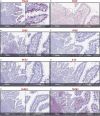Intraepithelial lymphocytes in the pig intestine: T cell and innate lymphoid cell contributions to intestinal barrier immunity
- PMID: 36569897
- PMCID: PMC9772029
- DOI: 10.3389/fimmu.2022.1048708
Intraepithelial lymphocytes in the pig intestine: T cell and innate lymphoid cell contributions to intestinal barrier immunity
Abstract
Intraepithelial lymphocytes (IELs) include T cells and innate lymphoid cells that are important mediators of intestinal immunity and barrier defense, yet most knowledge of IELs is derived from the study of humans and rodent models. Pigs are an important global food source and promising biomedical model, yet relatively little is known about IELs in the porcine intestine, especially during formative ages of intestinal development. Due to the biological significance of IELs, global importance of pig health, and potential of early life events to influence IELs, we collate current knowledge of porcine IEL functional and phenotypic maturation in the context of the developing intestinal tract and outline areas where further research is needed. Based on available findings, we formulate probable implications of IELs on intestinal and overall health outcomes and highlight key findings in relation to human IELs to emphasize potential applicability of pigs as a biomedical model for intestinal IEL research. Review of current literature suggests the study of porcine intestinal IELs as an exciting research frontier with dual application for betterment of animal and human health.
Keywords: T lymphocyte; biomedical model; epithelial barrier; innate lymphoid cell 1; intestinal epithelium; intestinal lymphocyte; porcine; swine.
Copyright © 2022 Wiarda and Loving.
Conflict of interest statement
The authors declare that the research was conducted in the absence of any commercial or financial relationships that could be construed as a potential conflict of interest.
Figures





Similar articles
-
Intestinal location- and age-specific variation of intraepithelial T lymphocytes and mucosal microbiota in pigs.Dev Comp Immunol. 2023 Feb;139:104590. doi: 10.1016/j.dci.2022.104590. Epub 2022 Nov 19. Dev Comp Immunol. 2023. PMID: 36410569
-
Intraepithelial Lymphocytes of the Intestine.Annu Rev Immunol. 2024 Jun;42(1):289-316. doi: 10.1146/annurev-immunol-090222-100246. Epub 2024 Jun 14. Annu Rev Immunol. 2024. PMID: 38277691 Free PMC article. Review.
-
Intestinal Intraepithelial Lymphocytes: Sentinels of the Mucosal Barrier.Trends Immunol. 2018 Apr;39(4):264-275. doi: 10.1016/j.it.2017.11.003. Epub 2017 Dec 5. Trends Immunol. 2018. PMID: 29221933 Free PMC article. Review.
-
Cytotoxic innate intraepithelial lymphocytes control early stages of Cryptosporidium infection.Front Immunol. 2023 Sep 6;14:1229406. doi: 10.3389/fimmu.2023.1229406. eCollection 2023. Front Immunol. 2023. PMID: 37744354 Free PMC article.
-
Extracellular CIRP induces CD4CD8αα intraepithelial lymphocyte cytotoxicity in sepsis.Mol Med. 2024 Feb 1;30(1):17. doi: 10.1186/s10020-024-00790-2. Mol Med. 2024. PMID: 38302880 Free PMC article.
Cited by
-
Acute and persistent effects of oral glutamine supplementation on growth, cellular proliferation, and tight junction protein transcript abundance in jejunal tissue of low and normal birthweight pre-weaning piglets.PLoS One. 2024 Jan 2;19(1):e0296427. doi: 10.1371/journal.pone.0296427. eCollection 2024. PLoS One. 2024. PMID: 38165864 Free PMC article.
-
Weaning age impacts intestinal stabilization of jejunal intraepithelial T lymphocytes and mucosal microbiota in pigs.BMC Vet Res. 2025 Jul 19;21(1):477. doi: 10.1186/s12917-025-04850-5. BMC Vet Res. 2025. PMID: 40684157 Free PMC article.
-
A TriAdj-Adjuvanted Chlamydia trachomatis CPAF Protein Vaccine Is Highly Immunogenic in Pigs.Vaccines (Basel). 2024 Apr 16;12(4):423. doi: 10.3390/vaccines12040423. Vaccines (Basel). 2024. PMID: 38675805 Free PMC article.
-
Porcine γδ T cells express cytotoxic cell-associated markers and display killing activity but are not selectively cytotoxic against PRRSV- or swIAV-infected macrophages.Front Immunol. 2024 Jul 31;15:1434011. doi: 10.3389/fimmu.2024.1434011. eCollection 2024. Front Immunol. 2024. PMID: 39144143 Free PMC article.
-
Pig jejunal single-cell RNA landscapes revealing breed-specific immunology differentiation at various domestication stages.Front Immunol. 2025 Feb 28;16:1530214. doi: 10.3389/fimmu.2025.1530214. eCollection 2025. Front Immunol. 2025. PMID: 40151618 Free PMC article.
References
Publication types
MeSH terms
LinkOut - more resources
Full Text Sources

